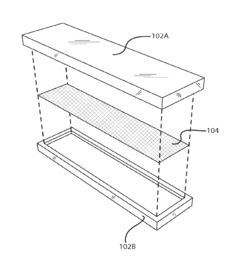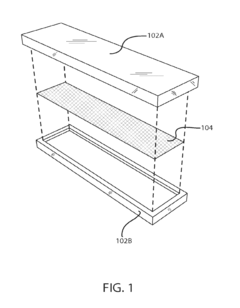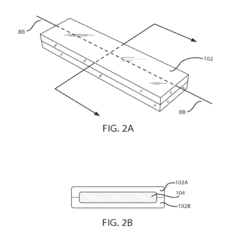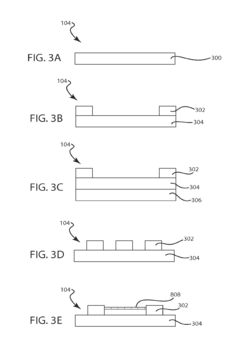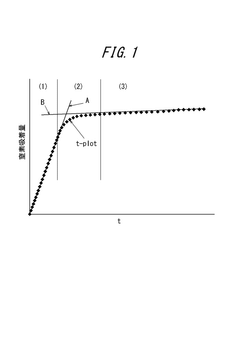Silicone Rubber Contributions to High-End Robotics Flexibility
JUL 8, 20259 MIN READ
Generate Your Research Report Instantly with AI Agent
Patsnap Eureka helps you evaluate technical feasibility & market potential.
Silicone Rubber in Robotics: Background and Objectives
Silicone rubber has emerged as a pivotal material in the field of high-end robotics, revolutionizing the way we approach flexibility and adaptability in robotic systems. The journey of silicone rubber in robotics can be traced back to the early 2000s when researchers began exploring soft materials for more compliant and safer human-robot interactions. As traditional rigid robots faced limitations in delicate tasks and human-centric environments, the need for more flexible and adaptable robotic systems became apparent.
The evolution of silicone rubber in robotics has been driven by the increasing demand for robots that can operate in unstructured environments and perform tasks requiring dexterity and gentleness. This material's unique properties, including high elasticity, biocompatibility, and chemical stability, have made it an ideal candidate for developing soft robotic components. The goal of incorporating silicone rubber into high-end robotics is to create machines that can mimic the flexibility and adaptability of biological systems while maintaining the precision and strength of traditional robots.
Over the past decade, significant advancements have been made in the synthesis and fabrication of silicone rubber compounds specifically tailored for robotic applications. These developments have led to the creation of actuators, sensors, and structural components that can undergo large deformations without failure, enabling robots to navigate complex environments and interact safely with humans and delicate objects.
The technological objectives in this field are multifaceted. Researchers and engineers aim to enhance the mechanical properties of silicone rubber to improve its durability and performance under various conditions. This includes developing silicone formulations with tunable stiffness, self-healing capabilities, and improved thermal and electrical conductivity. Another key objective is to integrate silicone rubber components seamlessly with traditional robotic systems, creating hybrid robots that combine the best of both rigid and soft robotics.
Furthermore, the field is moving towards the development of advanced manufacturing techniques for silicone rubber components, such as 3D printing and molding processes that allow for intricate designs and multi-material structures. These advancements are crucial for creating more sophisticated and capable robotic systems that can address complex challenges in healthcare, manufacturing, and exploration.
As we look to the future, the integration of silicone rubber in high-end robotics is expected to play a crucial role in the development of next-generation robotic systems. The ongoing research and development in this area aim to push the boundaries of what is possible in robotics, potentially leading to breakthroughs in prosthetics, minimally invasive surgery, disaster response robots, and adaptive industrial automation.
The evolution of silicone rubber in robotics has been driven by the increasing demand for robots that can operate in unstructured environments and perform tasks requiring dexterity and gentleness. This material's unique properties, including high elasticity, biocompatibility, and chemical stability, have made it an ideal candidate for developing soft robotic components. The goal of incorporating silicone rubber into high-end robotics is to create machines that can mimic the flexibility and adaptability of biological systems while maintaining the precision and strength of traditional robots.
Over the past decade, significant advancements have been made in the synthesis and fabrication of silicone rubber compounds specifically tailored for robotic applications. These developments have led to the creation of actuators, sensors, and structural components that can undergo large deformations without failure, enabling robots to navigate complex environments and interact safely with humans and delicate objects.
The technological objectives in this field are multifaceted. Researchers and engineers aim to enhance the mechanical properties of silicone rubber to improve its durability and performance under various conditions. This includes developing silicone formulations with tunable stiffness, self-healing capabilities, and improved thermal and electrical conductivity. Another key objective is to integrate silicone rubber components seamlessly with traditional robotic systems, creating hybrid robots that combine the best of both rigid and soft robotics.
Furthermore, the field is moving towards the development of advanced manufacturing techniques for silicone rubber components, such as 3D printing and molding processes that allow for intricate designs and multi-material structures. These advancements are crucial for creating more sophisticated and capable robotic systems that can address complex challenges in healthcare, manufacturing, and exploration.
As we look to the future, the integration of silicone rubber in high-end robotics is expected to play a crucial role in the development of next-generation robotic systems. The ongoing research and development in this area aim to push the boundaries of what is possible in robotics, potentially leading to breakthroughs in prosthetics, minimally invasive surgery, disaster response robots, and adaptive industrial automation.
Market Demand for Flexible Robotic Systems
The demand for flexible robotic systems has been steadily increasing across various industries, driven by the need for adaptable automation solutions in complex manufacturing environments. High-end robotics with enhanced flexibility are particularly sought after in sectors such as automotive, electronics, healthcare, and aerospace, where precision and adaptability are paramount.
In the automotive industry, flexible robotic systems are essential for handling diverse tasks in assembly lines, from welding and painting to intricate component installation. The ability to quickly reconfigure these systems for different vehicle models or production changes is a key factor driving market demand. Similarly, in electronics manufacturing, the rapid product cycles and miniaturization trends necessitate robots that can delicately handle small components and adapt to frequent changes in product designs.
The healthcare sector presents a growing market for flexible robotic systems, particularly in surgical applications. Surgeons require robots with high dexterity and precise control for minimally invasive procedures. The demand for robots that can mimic human-like movements and provide tactile feedback is pushing the boundaries of robotic flexibility.
Aerospace manufacturing, with its complex assembly processes and high-value components, is another significant driver of demand for flexible robotic systems. The need for robots that can work in confined spaces and perform intricate tasks with high precision is fueling innovation in this sector.
The global market for flexible robotic systems is expected to grow substantially in the coming years. This growth is attributed to factors such as increasing labor costs, the need for consistent quality in manufacturing, and the push for Industry 4.0 initiatives. Companies are increasingly looking for robotic solutions that can be easily reprogrammed and redeployed across different production lines, reducing downtime and increasing overall efficiency.
The integration of advanced sensors, artificial intelligence, and machine learning capabilities is further enhancing the appeal of flexible robotic systems. These technologies enable robots to adapt to their environment in real-time, making decisions based on sensory input and improving their performance over time. This level of autonomy and adaptability is particularly valuable in dynamic manufacturing environments.
As industries continue to evolve and face new challenges, the demand for even more flexible and versatile robotic systems is expected to grow. The ability of silicone rubber to contribute to this flexibility, through its unique properties such as elasticity, durability, and resistance to extreme conditions, positions it as a critical material in the development of next-generation robotic systems.
In the automotive industry, flexible robotic systems are essential for handling diverse tasks in assembly lines, from welding and painting to intricate component installation. The ability to quickly reconfigure these systems for different vehicle models or production changes is a key factor driving market demand. Similarly, in electronics manufacturing, the rapid product cycles and miniaturization trends necessitate robots that can delicately handle small components and adapt to frequent changes in product designs.
The healthcare sector presents a growing market for flexible robotic systems, particularly in surgical applications. Surgeons require robots with high dexterity and precise control for minimally invasive procedures. The demand for robots that can mimic human-like movements and provide tactile feedback is pushing the boundaries of robotic flexibility.
Aerospace manufacturing, with its complex assembly processes and high-value components, is another significant driver of demand for flexible robotic systems. The need for robots that can work in confined spaces and perform intricate tasks with high precision is fueling innovation in this sector.
The global market for flexible robotic systems is expected to grow substantially in the coming years. This growth is attributed to factors such as increasing labor costs, the need for consistent quality in manufacturing, and the push for Industry 4.0 initiatives. Companies are increasingly looking for robotic solutions that can be easily reprogrammed and redeployed across different production lines, reducing downtime and increasing overall efficiency.
The integration of advanced sensors, artificial intelligence, and machine learning capabilities is further enhancing the appeal of flexible robotic systems. These technologies enable robots to adapt to their environment in real-time, making decisions based on sensory input and improving their performance over time. This level of autonomy and adaptability is particularly valuable in dynamic manufacturing environments.
As industries continue to evolve and face new challenges, the demand for even more flexible and versatile robotic systems is expected to grow. The ability of silicone rubber to contribute to this flexibility, through its unique properties such as elasticity, durability, and resistance to extreme conditions, positions it as a critical material in the development of next-generation robotic systems.
Current State and Challenges of Silicone Rubber in Robotics
Silicone rubber has emerged as a crucial material in the field of high-end robotics, offering unique properties that contribute significantly to the flexibility and adaptability of robotic systems. Currently, the integration of silicone rubber in robotics is at an advanced stage, with numerous applications across various sectors, including industrial automation, healthcare, and consumer electronics.
The current state of silicone rubber in robotics is characterized by its widespread use in soft robotics, where it serves as a primary material for creating flexible and compliant structures. This has enabled the development of robots capable of interacting safely with humans and delicate objects, a critical advancement in human-robot collaboration scenarios. Silicone rubber's ability to mimic biological tissues has also led to breakthroughs in biomedical robotics, particularly in the creation of prosthetics and assistive devices.
However, despite these advancements, several challenges persist in the application of silicone rubber in high-end robotics. One of the primary obstacles is the limited durability of silicone rubber components under repeated stress and strain. While silicone rubber exhibits excellent initial flexibility, prolonged use in dynamic robotic applications can lead to material fatigue and degradation, potentially compromising the robot's performance over time.
Another significant challenge lies in achieving precise control and actuation of silicone rubber-based robotic structures. The inherent softness and compliance of the material, while beneficial for certain applications, can make it difficult to achieve the level of precision required in high-end robotics. This is particularly evident in tasks that demand accurate positioning or force control.
The integration of sensors and actuators within silicone rubber structures presents another hurdle. While progress has been made in embedding electronic components within silicone matrices, ensuring reliable and long-lasting connections remains a challenge. The development of robust methods for integrating sensing and actuation capabilities without compromising the material's flexibility is an ongoing area of research.
Furthermore, the manufacturing processes for complex silicone rubber components in robotics are still evolving. Current techniques often involve manual fabrication or limited-scale production methods, which can be time-consuming and costly. Scaling up production while maintaining consistency and quality across batches is a significant challenge that needs to be addressed for wider adoption in high-end robotics.
Lastly, the thermal management of silicone rubber components in robotic systems poses a challenge. While silicone rubber offers good thermal insulation properties, this can lead to heat buildup in active robotic components, potentially affecting performance and longevity. Developing effective heat dissipation strategies for silicone rubber-based robotic structures is crucial for their reliable operation in demanding applications.
The current state of silicone rubber in robotics is characterized by its widespread use in soft robotics, where it serves as a primary material for creating flexible and compliant structures. This has enabled the development of robots capable of interacting safely with humans and delicate objects, a critical advancement in human-robot collaboration scenarios. Silicone rubber's ability to mimic biological tissues has also led to breakthroughs in biomedical robotics, particularly in the creation of prosthetics and assistive devices.
However, despite these advancements, several challenges persist in the application of silicone rubber in high-end robotics. One of the primary obstacles is the limited durability of silicone rubber components under repeated stress and strain. While silicone rubber exhibits excellent initial flexibility, prolonged use in dynamic robotic applications can lead to material fatigue and degradation, potentially compromising the robot's performance over time.
Another significant challenge lies in achieving precise control and actuation of silicone rubber-based robotic structures. The inherent softness and compliance of the material, while beneficial for certain applications, can make it difficult to achieve the level of precision required in high-end robotics. This is particularly evident in tasks that demand accurate positioning or force control.
The integration of sensors and actuators within silicone rubber structures presents another hurdle. While progress has been made in embedding electronic components within silicone matrices, ensuring reliable and long-lasting connections remains a challenge. The development of robust methods for integrating sensing and actuation capabilities without compromising the material's flexibility is an ongoing area of research.
Furthermore, the manufacturing processes for complex silicone rubber components in robotics are still evolving. Current techniques often involve manual fabrication or limited-scale production methods, which can be time-consuming and costly. Scaling up production while maintaining consistency and quality across batches is a significant challenge that needs to be addressed for wider adoption in high-end robotics.
Lastly, the thermal management of silicone rubber components in robotic systems poses a challenge. While silicone rubber offers good thermal insulation properties, this can lead to heat buildup in active robotic components, potentially affecting performance and longevity. Developing effective heat dissipation strategies for silicone rubber-based robotic structures is crucial for their reliable operation in demanding applications.
Existing Silicone Rubber Solutions for Robotic Flexibility
01 Silicone rubber composition for improved flexibility
Specific silicone rubber compositions can be formulated to enhance flexibility. These compositions may include various additives, fillers, or cross-linking agents that contribute to the overall flexibility of the silicone rubber. The careful selection and balance of these components can result in silicone rubber with superior flexibility properties.- Composition modifications for improved flexibility: Silicone rubber flexibility can be enhanced by modifying its composition. This includes adjusting the ratio of different silicone polymers, incorporating specific additives, or using specialized cross-linking agents. These modifications can alter the molecular structure of the silicone rubber, resulting in improved elasticity and flexibility without compromising other desirable properties.
- Filler materials for flexibility enhancement: The addition of specific filler materials to silicone rubber formulations can significantly impact flexibility. Certain fillers, such as fumed silica or carbon black, can be used in controlled amounts to enhance the rubber's flexibility while maintaining its strength. The type, size, and distribution of these fillers play crucial roles in determining the final flexibility characteristics of the silicone rubber.
- Heat treatment processes for flexibility adjustment: Various heat treatment processes can be employed to adjust the flexibility of silicone rubber. These may include post-curing at specific temperatures, annealing, or controlled cooling rates. Such thermal processes can affect the cross-linking density and molecular arrangement of the silicone rubber, thereby influencing its flexibility and other mechanical properties.
- Surface modification techniques: Surface modification techniques can be applied to silicone rubber to enhance its flexibility, especially in specific applications. These may include plasma treatment, chemical etching, or the application of specialized coatings. Such modifications can alter the surface properties of the silicone rubber, affecting its flexibility and interaction with other materials or environments.
- Blending with other elastomers: Blending silicone rubber with other elastomers or polymers can be an effective method to enhance its flexibility. This approach allows for the combination of the desirable properties of silicone rubber with the flexibility characteristics of other materials. The selection of compatible elastomers and the optimization of blending ratios are crucial for achieving the desired flexibility while maintaining other important properties.
02 Heat treatment to enhance silicone rubber flexibility
Heat treatment processes can be applied to silicone rubber to improve its flexibility. This may involve specific heating cycles or temperature ranges that modify the molecular structure of the silicone rubber, resulting in increased flexibility without compromising other desirable properties.Expand Specific Solutions03 Incorporation of elastomeric additives
The addition of elastomeric additives to silicone rubber formulations can significantly enhance flexibility. These additives may include specific polymers or elastomers that are compatible with silicone and contribute to the overall elasticity and flexibility of the final product.Expand Specific Solutions04 Surface modification techniques for flexible silicone rubber
Various surface modification techniques can be applied to silicone rubber to improve its flexibility. These may include chemical treatments, plasma treatments, or the application of specific coatings that alter the surface properties of the silicone rubber, resulting in enhanced flexibility.Expand Specific Solutions05 Blending silicone rubber with other flexible materials
Blending silicone rubber with other flexible materials or polymers can result in a composite material with improved flexibility. This approach combines the desirable properties of silicone rubber with the flexibility characteristics of other materials to achieve an optimal balance of properties.Expand Specific Solutions
Key Players in Silicone Rubber and Robotics Industries
The silicone rubber market for high-end robotics flexibility is in a growth phase, driven by increasing demand for advanced robotics across industries. The market size is expanding rapidly, with major players like Shin-Etsu Chemical, Wacker Chemie, and Momentive Performance Materials leading the way. These companies demonstrate high technological maturity, offering specialized silicone rubber formulations tailored for robotic applications. Emerging players such as Guangzhou Ruihe and Shandong Tairuifeng are also contributing to market innovation. The competitive landscape is characterized by ongoing R&D efforts to enhance material properties like flexibility, durability, and temperature resistance, crucial for advancing robotic capabilities in various sectors.
Shin-Etsu Chemical Co., Ltd.
Technical Solution: Shin-Etsu Chemical has developed advanced silicone rubber compounds specifically tailored for high-end robotics applications. Their proprietary formulations offer enhanced flexibility and durability, crucial for robotic joints and actuators. The company's silicone elastomers demonstrate excellent resistance to extreme temperatures (-50°C to 200°C) and maintain consistent performance over extended periods[1]. Shin-Etsu's silicone rubber solutions incorporate nano-scale reinforcing agents, resulting in improved tear strength and elongation properties, which are essential for robotic skin and flexible sensors[2]. Their materials also exhibit low compression set, ensuring long-term dimensional stability in dynamic robotic applications[3].
Strengths: Superior flexibility and durability, wide temperature resistance, and excellent long-term stability. Weaknesses: Potentially higher cost compared to conventional rubber materials, and may require specialized processing techniques.
Wacker Chemie AG
Technical Solution: Wacker Chemie has pioneered the development of liquid silicone rubber (LSR) technology for high-end robotics. Their ELASTOSIL® LR series offers a range of shore hardnesses (from 5 to 80 Shore A) suitable for various robotic applications[1]. Wacker's self-adhesive LSR grades enable multi-component designs, allowing for the integration of rigid and flexible parts in robotic structures[2]. The company has also introduced electrically conductive silicone rubbers, facilitating the creation of stretchable electronics and sensors for advanced robotic systems[3]. Wacker's materials demonstrate excellent biocompatibility, making them suitable for medical and collaborative robotics applications where human contact is frequent[4].
Strengths: Versatile product range, innovative self-adhesive and conductive formulations, and biocompatibility for human-robot interaction. Weaknesses: May require specialized molding equipment and processes, potentially limiting accessibility for smaller manufacturers.
Core Innovations in Silicone Rubber for Robotics
Flexibility-controlled composite material and method of manufacture
PatentActiveUS20160250782A1
Innovation
- A composite material is created by combining silicone rubber with a second material that resists elongation, such as fiber strands or woven fabric, which is encapsulated within the silicone rubber, allowing for controlled flexibility and preservation of other characteristics like drape-ability.
Silicone rubber composition and vulcanized object
PatentWO2016136275A1
Innovation
- Incorporating a fibrous carbon nanostructure with specific properties, such as an upwardly convex t-plot from nitrogen adsorption isotherm, and average diameters between 2-10 nm, along with graphite, to enhance conductivity while minimizing hardness increase.
Environmental Impact of Silicone Rubber in Robotics
The use of silicone rubber in high-end robotics has significant environmental implications that warrant careful consideration. As robotics technology advances, the demand for flexible and durable materials like silicone rubber continues to grow. However, this increased usage raises concerns about the environmental impact throughout the lifecycle of robotic systems.
Silicone rubber production involves energy-intensive processes and the use of various chemicals, which can contribute to greenhouse gas emissions and potential pollution if not properly managed. The manufacturing of silicone rubber requires the extraction of raw materials, primarily silica and hydrocarbons, which can lead to habitat disruption and resource depletion.
During the operational phase of robots, silicone rubber components generally have a positive environmental impact due to their durability and longevity. These properties reduce the need for frequent replacements, thereby minimizing waste generation and resource consumption. Additionally, the flexibility and resilience of silicone rubber enable the development of more energy-efficient robotic systems, potentially reducing overall energy consumption in various applications.
End-of-life considerations for silicone rubber in robotics present both challenges and opportunities. While silicone rubber is not biodegradable, it can be recycled through specialized processes. However, the complex nature of robotic systems often makes it difficult to separate silicone components from other materials, potentially limiting recycling efforts. Proper disposal and recycling infrastructure are crucial to mitigate the environmental impact of discarded robotic parts.
The use of silicone rubber in robotics also has indirect environmental benefits. Robots equipped with flexible silicone components can perform tasks more efficiently and precisely, leading to reduced waste and improved resource utilization in various industries. For instance, in manufacturing and agriculture, robots with silicone-based grippers can handle delicate items with greater care, reducing product damage and associated waste.
As environmental concerns become increasingly prominent, there is a growing focus on developing eco-friendly alternatives to traditional silicone rubber. Research into bio-based silicones and other sustainable elastomers shows promise for reducing the environmental footprint of robotics. These innovations aim to maintain the desirable properties of silicone rubber while minimizing negative environmental impacts.
In conclusion, while silicone rubber contributes significantly to the flexibility and performance of high-end robotics, its environmental impact is complex and multifaceted. Balancing the benefits of improved robotic capabilities with environmental considerations requires ongoing research, innovation, and responsible manufacturing and disposal practices. As the robotics industry evolves, it must prioritize sustainable material choices and lifecycle management to ensure that technological advancements align with environmental stewardship.
Silicone rubber production involves energy-intensive processes and the use of various chemicals, which can contribute to greenhouse gas emissions and potential pollution if not properly managed. The manufacturing of silicone rubber requires the extraction of raw materials, primarily silica and hydrocarbons, which can lead to habitat disruption and resource depletion.
During the operational phase of robots, silicone rubber components generally have a positive environmental impact due to their durability and longevity. These properties reduce the need for frequent replacements, thereby minimizing waste generation and resource consumption. Additionally, the flexibility and resilience of silicone rubber enable the development of more energy-efficient robotic systems, potentially reducing overall energy consumption in various applications.
End-of-life considerations for silicone rubber in robotics present both challenges and opportunities. While silicone rubber is not biodegradable, it can be recycled through specialized processes. However, the complex nature of robotic systems often makes it difficult to separate silicone components from other materials, potentially limiting recycling efforts. Proper disposal and recycling infrastructure are crucial to mitigate the environmental impact of discarded robotic parts.
The use of silicone rubber in robotics also has indirect environmental benefits. Robots equipped with flexible silicone components can perform tasks more efficiently and precisely, leading to reduced waste and improved resource utilization in various industries. For instance, in manufacturing and agriculture, robots with silicone-based grippers can handle delicate items with greater care, reducing product damage and associated waste.
As environmental concerns become increasingly prominent, there is a growing focus on developing eco-friendly alternatives to traditional silicone rubber. Research into bio-based silicones and other sustainable elastomers shows promise for reducing the environmental footprint of robotics. These innovations aim to maintain the desirable properties of silicone rubber while minimizing negative environmental impacts.
In conclusion, while silicone rubber contributes significantly to the flexibility and performance of high-end robotics, its environmental impact is complex and multifaceted. Balancing the benefits of improved robotic capabilities with environmental considerations requires ongoing research, innovation, and responsible manufacturing and disposal practices. As the robotics industry evolves, it must prioritize sustainable material choices and lifecycle management to ensure that technological advancements align with environmental stewardship.
Human-Robot Interaction Enhancements with Silicone Rubber
Silicone rubber has emerged as a game-changing material in enhancing human-robot interaction within high-end robotics. Its unique properties, including flexibility, durability, and biocompatibility, have opened up new possibilities for creating more natural and intuitive interfaces between humans and robotic systems.
One of the primary contributions of silicone rubber in this field is its ability to mimic human skin-like textures. This characteristic allows for the development of robotic surfaces that feel more lifelike to the touch, significantly improving the tactile experience during human-robot interactions. The soft and pliable nature of silicone rubber enables the creation of robotic components that can safely come into contact with human skin without causing discomfort or injury.
In the realm of haptic feedback, silicone rubber has proven invaluable. By incorporating silicone-based sensors and actuators into robotic systems, engineers can create more sophisticated touch-sensitive interfaces. These interfaces can detect and respond to various types of physical interactions, such as pressure, temperature, and texture, allowing robots to provide more nuanced and context-appropriate responses to human touch.
The flexibility of silicone rubber also contributes to the development of more adaptable and compliant robotic structures. This property is particularly beneficial in collaborative robotics, where robots work alongside humans in shared spaces. Silicone-based components can absorb impacts and conform to irregular shapes, reducing the risk of injury during accidental collisions and enabling safer human-robot collaboration in various industrial and healthcare settings.
Furthermore, silicone rubber's biocompatibility makes it an excellent material for developing prosthetic devices and rehabilitation robotics. Its ability to interface comfortably with human tissue allows for the creation of more natural-feeling and functional prosthetic limbs, enhancing the quality of life for individuals with disabilities. In rehabilitation robotics, silicone-based components can provide gentle, controlled assistance to patients, facilitating more effective and comfortable therapy sessions.
The use of silicone rubber in soft robotics has also revolutionized the way robots interact with their environment and human operators. Soft robotic grippers and manipulators made from silicone can handle delicate objects with unprecedented dexterity, opening up new applications in fields such as food handling, healthcare, and delicate manufacturing processes. This enhanced adaptability allows robots to interact more safely and effectively with a wider range of objects and surfaces, bridging the gap between human-like manipulation and traditional rigid robotics.
One of the primary contributions of silicone rubber in this field is its ability to mimic human skin-like textures. This characteristic allows for the development of robotic surfaces that feel more lifelike to the touch, significantly improving the tactile experience during human-robot interactions. The soft and pliable nature of silicone rubber enables the creation of robotic components that can safely come into contact with human skin without causing discomfort or injury.
In the realm of haptic feedback, silicone rubber has proven invaluable. By incorporating silicone-based sensors and actuators into robotic systems, engineers can create more sophisticated touch-sensitive interfaces. These interfaces can detect and respond to various types of physical interactions, such as pressure, temperature, and texture, allowing robots to provide more nuanced and context-appropriate responses to human touch.
The flexibility of silicone rubber also contributes to the development of more adaptable and compliant robotic structures. This property is particularly beneficial in collaborative robotics, where robots work alongside humans in shared spaces. Silicone-based components can absorb impacts and conform to irregular shapes, reducing the risk of injury during accidental collisions and enabling safer human-robot collaboration in various industrial and healthcare settings.
Furthermore, silicone rubber's biocompatibility makes it an excellent material for developing prosthetic devices and rehabilitation robotics. Its ability to interface comfortably with human tissue allows for the creation of more natural-feeling and functional prosthetic limbs, enhancing the quality of life for individuals with disabilities. In rehabilitation robotics, silicone-based components can provide gentle, controlled assistance to patients, facilitating more effective and comfortable therapy sessions.
The use of silicone rubber in soft robotics has also revolutionized the way robots interact with their environment and human operators. Soft robotic grippers and manipulators made from silicone can handle delicate objects with unprecedented dexterity, opening up new applications in fields such as food handling, healthcare, and delicate manufacturing processes. This enhanced adaptability allows robots to interact more safely and effectively with a wider range of objects and surfaces, bridging the gap between human-like manipulation and traditional rigid robotics.
Unlock deeper insights with Patsnap Eureka Quick Research — get a full tech report to explore trends and direct your research. Try now!
Generate Your Research Report Instantly with AI Agent
Supercharge your innovation with Patsnap Eureka AI Agent Platform!
